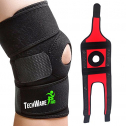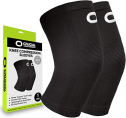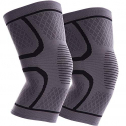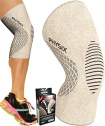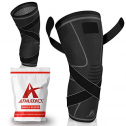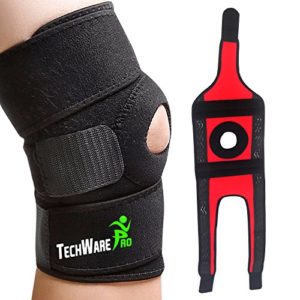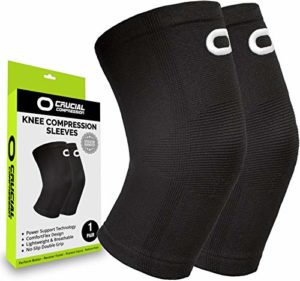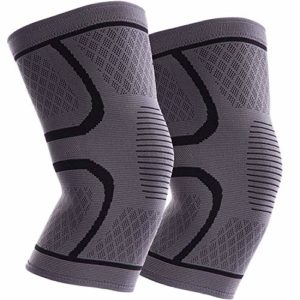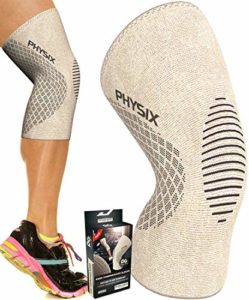Best Knee Brace For Torn Meniscus in April 2024
A torn meniscus is a painful condition that can be difficult to treat. It is caused by damage to the cartilage between the tibia and femur, which can occur during sports or other activities.
Meniscus tears are also often the result of degenerative osteoarthritis, a condition that affects the joints.
There are many knee braces on the market that are designed for use after a meniscus tear. They’re typically made of high-grade neoprene or elastic straps, and some also have more sophisticated features like adjustable straps and gel pads that help reduce discomfort. The conventional wisdom is that wearing a brace can help reduce pain and speed up rehabilitation after a meniscus tear.
In this post, we provide a list of the 5 best braces for torn meniscus, backed by consumer reviews, that have been proven to be useful for people with this type of injury.
Choosing the right Knee Brace will help in torn meniscus recovery. By wearing a knee brace, you can help reduce your pain and instantly, reduce swelling, and recover faster. Without further ado, let’s dive in to the best knee braces for torn meniscus:
Top 5 Knee Brace For Torn Meniscus (Quick List)
Top 5 Knee Braces For Torn Meniscus (Full Reviews)
1. TechWare Pro Knee Brace Support Review
The TechWare Pro Knee Brace is ideal for sports that stress the knee. This brace can stabilize the patella and promote the healing of damaged tissue. The TechWare Pro also features a patented removable dual stabilizer, which stabilizes the patella without pressing on it.
This means that it won't irritate or inflame an existing injury like other braces often do. The TechWare Pro also has a neoprene strap, which prevents any slippage of the mount. The Techware Pro is a great choice for athletes who need protection from injuries without impeding their mobility or complicating their recovery process in any way.
Great for the treatment of torn ACL ligaments, patellar tendonitis, ligament sprains. It prevents the knee from giving way when you are on your feet or during physical activity. Designed to provide compression, warmth, and support to the knee. Ideal for sports applications for training and rehabilitation. It fits left or right leg.
Conclusion: The best knee brace for a torn meniscus is one that minimizes movement of the kneecap around in the joint cavity without irritating already sensitive tissue or damaging healthy tissue.
Sizes Available: Medium to XX-Large
Material: Breathable Neoprene
Closure Type: Hook and Loop
- Effective stabilization of knee during activity
- Reliable support of the patella
- No annoying or painful buckles or straps
- Great price point.
- Durability of construction
- Not waterproof like many other options on the market today
2. Crucial Compression Meniscus Tear Knee Braces Review
The Crucial Compression Meniscus Knee Brace provides soothing relief for both meniscus injuries while offering excellent support. The Crucial Compression Meniscus Knee Brace is specially designed to offer protection and support for the knee joint.
This product will help relieve pain caused by inflammation and swelling of the joint, and it will stabilize the knee, preventing undesired movement or instability.
It provides a therapeutic compression for better blood circulation and is designed with premium nylon to be gentle on the skin while being strong enough to keep it tightly in place.
This knee strap won't bunch at leg opening or walk down at calf and give maximum support and comfort. It is machine washable and anti-microbial and can be used for both warm and cool therapy.
Sizes Available: X-Small to X-Large
Material: Premium Nylon / Spandex
Closure Type: Pull On
- It is easy to put on and remove
- It fits comfortably
- Machine Washable
- Decent compression
- Premium material construction
- It can be challenging to get into at first, but this becomes much easier with use.
3. ITHW Meniscus Tear Knee Brace Review
The ITHW Knee Brace is a highly adjustable and comfortable knee brace designed to help those recovering from meniscus tears. It allows for a full range of motion and can be worn in multiple positions: as a knee sleeve, a leg sleeve, or even as an over-the-knee blanket. The ITHW is made with top-quality materials that fit comfortably and snugly. It comes in four sizes and 2 colors, pink or black.
The ITHW Knee Brace was designed for both strains and tears. Strains are common in those who participate in athletics, while tears can occur in anyone. The ITHW Knee Brace is designed to protect new tissue that may be forming and stabilize the joint while you recover from your injury. Restoring your mobility quickly after a tear or strain is essential to avoiding long-term harm.
The ITHW Knee Brace's primary purpose is to protect the injured area from further damage and prevent it from getting worse. It is also a great way to help you stabilize the area as it heals.
The ITHW Knee Brace provides a compression force around the joint, reducing swelling and pain. Allowing your meniscus to heal correctly will speed up your recovery time. The ITHW Knee Brace can also be worn while you sleep, making sure that you have full support when resting as well.
The ITHW Knee Brace is made with certified medical-grade quality materials that are soft and comfortable against the skin, even when worn for long periods. It has a unique open weave design that makes it breathable and less constricting than other knee braces on the market.
Sizes Available: Medium to XX-Large
Material: Silica Gel / Latex /Gelatin
Closure Type: Pull On
- Medical-grade quality
- Does not roll down
- Can be hand-washed
- Excellent value and fairly priced
- A bit loose at the knee cap
4. Physix Gear Knee Support Brace for Meniscus Tear Review
Physix Knee Brace is the best budget knee braces on the market and is made by a company designing orthopedic products for more than 25 years.
Physix's revolutionary design uses a four-way stretch fabric for increased durability, stability, and comfort. The soft neoprene lining will ensure you don't experience any chafing or pressure points from the brace. At the same time, the high-quality material provides superior protection to your knees during intense activity. Physix also features a quick-release auto-locking buckle system so you can easily pull your brace tight when you're putting it on without having to
The sizing of your knee brace is essential to get right, or you risk having it become too loose and ineffective. To correctly size your Physix brace, you will need to measure the distance from your knee cap to the middle point between your upper thigh and lower calf joint. You should then choose the size that is closest to a quarter of this measurement.
Sizes Available: Small to XX-Large
Material: Nylon
Closure Type: Pull on
- Very affordable
- Premium material
- They wash well
- Exemely sturdy and tight yet it has a comfortable fit
- Does not come as a pair
5. Athledict Meniscus Tear Knee Brace Review
Athledict knee brace is considered one of the best knee braces for a torn meniscus and is a popular choice. It provides both medial and lateral support, giving you the best possible protection against another injury to your meniscus. It is easy to put on and take off, meaning you can wear it when necessary without feeling too cumbersome or constricted.
Athledict knee brace fits comfortably with most pants or slacks - it’s even machine-washable! The knee supports are secured with four Velcro straps: two straps on each side that stretch over the front of your leg and one across the back, which runs below your calf muscle. They resist slipping in all kinds of weather and conform well to most leg shapes.
Although the Athledict knee brace is rather bulky, it works well for mild meniscus injury cases and does not restrict movement. And because it’s so highly rated on Amazon, the straps are durable and will last you for all seasons.
Athledict is also well-known for designing knee braces for mild to moderate knee injuries perfect for people recovering from a torn meniscus or undergoing physical therapy. This sturdy knee support reduces pressures and pain on the knees and allows you to continue with your daily activities.
Sizes Available: X-Small to XXX-Large
Material: Nylon, Spandex
Closure Type: Pull on w/Strap
- Very comfortable to wear and does not feel overly constricting.
- Designed specifically for meniscus tears
- The brace also protects the PCL, which can be injured along with a meniscus tear.
- not suitable for everyone and some people report it being too stiff for their liking.
Frequently Asked Questions about Knee Braces For Torn Meniscus
What is a Meniscus Tear?
The meniscus is a piece of cartilage that sits between the thigh bone and shin bone. When the knee is bent, it provides a cushion for the bones to grind against each other. Therefore, a torn meniscus can cause pain, swelling, and joint locking if not treated immediately.
What is the best type of knee brace for a torn meniscus?
If you have a torn meniscus, there are a few things to consider before purchasing the best knee brace for you. You must find the right fit, or else it won’t be effective. You should also make sure that you purchase a brace with proper support so that your joints can heal adequately and strengthen.
How Do I Know If I Have A Torn Meniscus?
If you tore your meniscus, there’s a good chance you’ll have some symptoms. Some include:
It is swelling or bruising on or around your knee. This will look like dark discoloration of your skin around the area of the tear.
Pain that comes and goes.
Swelling around the knee joint. Tearing of the cartilage will cause fluid to build up in the torn area, causing swelling and pain.
There may be a “popping” sensation in your knee, followed by a shooting pain that radiates from it down your leg. The joint locking typically causes this due to swelling in your meniscus. If you experience this symptom, you should seek medical attention right away as this could lead to other problems such as a complete tear or even arthritis in the affected area.
The location of your tear can also influence some symptoms that you may experience after it happens. A tear on the outer edge of your meniscus can cause pain in the back of your knee. A tear on the inner edge can cause you to have pain behind and beside your knee.
How Is A Torn Meniscus Diagnosed?
Your doctor will examine your knee carefully and test the range of motion. They will look for swelling, discoloration and give your knee some twists to see if it locks up or causes you pain. Once they have a diagnosis, they will explain what course of treatment is best for you, whether that’s surgery or physical therapy. Many people choose to go with physical therapy because it’s less invasive and often provides longer-lasting results.
How Is A Torn Meniscus Treated?
If you have a torn meniscus, your doctor may recommend that you get physical therapy, especially if the tear is small. Physical therapy can help strengthen the muscles surrounding your knee joint so that you can adequately use it again. The good news is that once your meniscus is repaired, typically through surgery, most people can return to their regular activities.
However, it’s essential to stick with lower impact activities after this procedure for up to six months so that you can properly heal and strengthen your knee before going back to high-impact activities like running or playing sports.
How Can A Knee Brace Help with Meniscus Tears?
A knee brace can be beneficial to anyone who has a torn meniscus. It keeps the knee from moving around, which can worsen the injury and cause more pain. A knee brace also allows your meniscus to heal in a natural position, which promotes recovery time and reduces swelling and pain. The best type of knee brace depends on your particular needs after your injury. Some people want one that gives them more mobility while others want one that will lock their knees in place until they’re ready to go back to pre-injury activities.
No matter which type of brace you use, it’s essential to make sure that it fits correctly and that the joint is fully supported.
Toggle Title
What is the best knee brace for a torn meniscus?
The TechWare Pro Knee Brace is the best knee brace for a torn meniscus. This brace is highly adjustable, and it can be worn for up to six weeks after the injury. It comes with various straps that can be customized to fit your knee perfectly, so there’s no need to worry about it slipping off or injured areas being without protection. It also prevents your knee from twisting when you bend while walking, helping alleviate pain and swelling.
The TechWare Pro Knee Brace is the top of the line when it comes to braces for a torn meniscus, as it provides excellent stability throughout your healing process so that you’re able to get back on your feet and back to pre-injury activities quickly.
Do you have to wear your brace when you sleep after meniscus surgery?
You will likely need to wear your brace during the day for three months and up to six weeks after you go into surgery. Some doctors recommend that you wear your brace at night as well, but this is not necessary. Many people find that their knee feels swollen in the morning when they first put their brace on, and it’s too tight.
Can a torn meniscus be treated without surgery?
In some cases, a torn meniscus can be treated without surgery. However, if the tear is large or if the knee is unstable, surgery may be needed to stabilize and properly repair the area. This type of surgery can also be beneficial if you’ve had previous knee injuries as it can prevent stiffness and soreness.
Is it safe to have a torn meniscus surgically repaired?
Yes, it is safe to have a torn meniscus surgically repaired. Many patients are more comfortable having the surgery done when they have an acute tear than waiting until later, when the tear is more likely to become chronic. However, you should talk with your doctor about the risks associated with your specific type of tear if you’re on the fence about whether or not to have surgery.
Is it common for people to have a torn meniscus?
Tears of the meniscus are prevalent in both children and adults. Up to 30% of people will experience a torn meniscus before 65. There is no known reason as to why some people develop tears while others do not, but genetics can play a role in predisposing one person over another. It is also more likely that you will develop a tear if you are obese or active in high-impact activities such as running, wrestling, or rugby playing.
Can a torn meniscus be prevented?
Unfortunately, there is no current way to prevent a torn meniscus at this time. In the future, drug and surgical treatments may be available to help reduce the risk of developing one. But for now, the most effective way to prevent the injury is to stay active but avoid high-impact activities. This means you should participate in moderate exercises and sports such as walking and yoga rather than running or other high-impact sports like tennis or basketball.
How long does it take for my knee to heal after meniscus surgery?
The time it takes for your knee to heal after surgery depends on your age, the type and size of the tear in the meniscus, and whether or not you received any additional treatment.
Typical recovery time is between 4-6 weeks but can be longer depending on factors such as pre-existing conditions. Your doctor will give you a more accurate timeline when discussing your surgery options.
Does the torn meniscus get worse with time? Will I need a knee replacement?
Just like any other injury, an untreated torn meniscus may worsen over time. If you’ve experienced pain for some time or notice that the swelling and stiffness are getting worse, you should have your torn meniscus evaluated by a medical professional.
In most cases, treatment – whether that be surgery or physical therapy will help you get back to an active lifestyle with few restrictions. Some people suffer chronic tears of the meniscus, but this is rare and typically caused by misalignment of the knee. However, if you continue to experience issues with your knee even after treatment, it could be a sign of arthritis in either the meniscus or the knee joint itself. In these cases, it may eventually be necessary to consider a knee replacement.
Why do people have knee surgery to repair a torn meniscus?
Tearing your meniscus can be painful, mainly when it occurs in the front of your knee. Additionally, it may cause damage to the articular cartilage, which can lead to arthritis. If left untreated, these issues can continue to affect your knee and may lead to decreased mobility or even pain while walking.
When should I get my torn meniscus evaluated, and when should I seek treatment?
Some notice pain after they’ve experienced a meniscus tear, while others don’t feel any discomfort at all. If you feel pain after injuring your knee, it’s a good idea to seek treatment. However, if you notice swelling and stiffness in your knee, there’s a chance that you’ve torn your meniscus and should get it evaluated by a medical professional right away.
Although other conditions can cause swelling or stiffness in the knee area, the torn meniscus is the most common cause of this symptom, so it’s best to be safe rather than sorry.
How long does the recovery time for a torn meniscus take?
Recovery time for a torn meniscus depends on several factors, including your overall health and age. However, the average recovery time for a torn meniscus is between 6-8 weeks. This timeframe can vary widely depending on your circumstances and how severe your tear is.
How long does it take for a meniscus to heal?
Most people, including doctors, are under the impression that the meniscus does not heal independently and needs to be surgically repaired. However, the meniscus has been shown in recent studies to heal on its own in many cases. To see what studies have to say about the healing of the meniscus and whether it is due to the body’s natural healing process, read more here.
How Long Do Knee Braces Last?
A knee brace can last for a few months or up to one year, depending on how frequently you use it during your treatment and recovery process. It is best to use a knee brace as often as possible during this time so that your recovery is as complete as possible and you can get back to regular activities safely.
After surgery, patients generally return home within 24 hours of their procedure.
What are some excellent exercises for Torn Meniscus?
The key to healing a torn meniscus is strengthening and supporting the muscles surrounding the knee joint. The best way to do this is by using a knee brace or other external support device that keeps the knee stable and reduces stress on the injured area. It would help if you also focused on lower impact activities such as swimming, biking, Pilates, or yoga so that your muscles can relax and heal properly.
What do you want in a knee brace for meniscus injury sports?
When choosing a knee brace for a meniscus injury, the most important thing to consider is how much support and protection you need. It would help if you chose a knee brace that can withstand your activities without slipping or feeling loose. It’s also essential to choose a knee brace that provides maximum support and protection without restricting your natural range of motion.
Should you wear a knee brace when exercising with a meniscus tear?
If you have a torn meniscus, you probably want to wear a knee brace when exercising. However, it’s essential to use your common sense and not push yourself too hard especially if you’re new to exercising. If you start to experience pain or notice that your knee is feeling unstable, stop what you’re doing and focus on healing the torn meniscus.
How long can I sleep without a brace after meniscus surgery?
In some cases, doctors recommend wearing a knee brace while sleeping to help provide extra stability and support. However, you should be careful if you choose to wear a knee brace at night to become uncomfortable and difficult to sleep with. You may find that wearing the brace for part of the day and not at night is more beneficial than risking the discomfort that many people experience when wearing a knee brace while sleeping.
How long do you wear a brace after meniscus repair?
It is essential to wear a brace after meniscus repair for at least three months, but some doctors recommend continuing to wear a brace up to six weeks after the injury. The reason for this is that the torn meniscus can still be weakened and unstable even if it’s been adequately repaired.
We help consumers find the right products to solve their problems and get results.
We do not sell the products, nor do we handle payments or customer service inquiries – we provide readers with an easy way to find the products they are looking for and a set of tools to help them make the best purchasing decision. In this sense, we are similar to Consumer Reports.
Amazon, Amazon Prime, the Amazon logo and Amazon Prime logo are trademarks of Amazon.com, Inc. or its affiliates.

